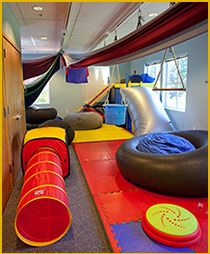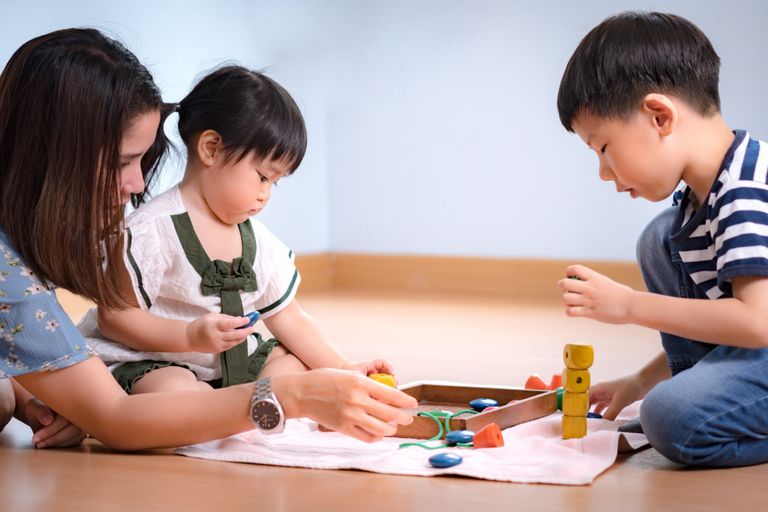Harbor Children’s Therapy uses evidence-based practice modalities in an engaging, safe environment. Occupational Therapy is a scientifically based use of purposeful, playful activities to improve cognitive, physical, emotional, social, and motor skills.
The goal is to reach the individual’s highest potential for independence in all areas of their lives, including play, school, and activities of daily living.
Our therapy environment invites the child into play interactions that stimulate growth in sensory, motor, perceptual, social, and language development. Our staff has creatively orchestrated the setting with innovative equipment and techniques which gives our clinic a unique approach to children and their families.
In addition to direct services, we also provide consultations to families, schools, childcare agencies, and other professionals.
Our Services

Ayres Sensory Integration Therapy ®
Based upon the pioneering work of Jean Ayres, sensory integration is the ability of the brain to take in, sort out, and respond to the sensory information we receive from the environment. It is especially important in individuals who are under/over-sensitive to sound, light, touch, noise, movement, taste, smell, etc.
Neurodevelopmental Treatment
Developed by the Bobaths, this treatment is based on the brain’s ability to reorganize and recover after neurological injury. This approach is frequently used with children with cerebral palsy and dysfunction in posture and movement patterns.
Handwriting Without Tears ®
A kinesthetic approach to teaching writing which follows a developmental teaching sequence with teaching letters in groups of similar strike sequence.
Who Might Need
Occupational Therapy?

Occupational Therapy serves a wide range of children with a variety of diagnoses. Many of the children we treat are just as intelligent as their peers but awkward in their physical or social skills. Their challenges could be in fine motor (hand skills), gross motor (big body coordination), learning (eye-hand coordination, visual-spatial awareness, directionality), social skills, and emotional regulation.
We define the child by his or her strengths and look for gaps in development that could be improved through therapy intervention.
Development is evaluated in postural control, sensory integration, motor planning, motor coordination, and visual-perceptual-motor development.
Signs of delays in gross motor coordination
- Poor balance, falls frequently
- Floppy, low muscle tone
- Fatigues quickly during physical play
Signs of delays in fine motor coordination
- Lacks dexterity for buttons, snaps, zippers
- Unable to use utensils for eating
- Poor handwriting, fatigues while writing
Signs of delays in visual-perception or visual-motor control
- Difficulty sustaining eye contact
- Handwriting delays with letter reversals, messy paper with irregular spacing, or colliding letters
- Loses place on line while reading
Signs of sensory integration disorder (SID):
- Overly sensitive or unusual reactions to touch, movement, sights, or sounds
- Fearful of heights or moving playground equipment
- No apparent awareness of dangers
- Easily distractible
- Social and/or emotional problems
- Unusually high or low level of activity
- Physical clumsiness or apparent carelessness
- Picky eater
- Difficulty making transitions from one situation to another
- Inability to self-calm
- Poor self-concept
- Difficulty in learning or planning motor skills
- Impulsivity or lack of self-control
- Delays in speech, language,
- Academic under achievement
Who We Serve?
Harbor Children’s Therapy is a family-centered occupational therapy clinic that provides services to children with a variety of diagnoses including but not limited to:
- Autism Spectrum Disorders
- Sensory Processing and Integration Disorders
- Down Syndrome
- ADHD
- Delayed Motor Coordination
- Visual-Perceptual-Motor Delays
- Handwriting Delays
- Other psychosocial, musculoskeletal, neurological, and learning disorders.
FAQs
What is occupational therapy?
Occupational therapy is a scientifically based use of purposeful, playful activities to improve cognitive, physical, emotional, social, and motor skills. The goal is to reach the individual’s highest potential for independence in all areas of their lives, including play, school, and activities of daily living. In children we evaluate skills in motor coordination, school performance (handwriting, visual-perceptual-skills, organizational skills), interactive play skills, and independence in self-care (dressing, bathing, eating).
How is occupational therapy different from physical therapy?
Although both types of therapy help improve the quality of lives, there are differences. Physical therapy deals with the issues of pain, strength, joint range of motion, endurance, and gross motor functioning. Occupational therapy deals more with the fine motor skills, visual-perceptual skills, sensory processing, play, and social interaction skills. However, this can vary depending on the experience and training of the therapist. The physical therapist who works at Harbor Children’s Therapy is also certified in sensory integration and has additional training in working with visual-perceptual-motor delays.
What is sensory integration? What is sensory integration dysfunction? What are possible causes?
Sensory integration is a term that refers to the way the nervous system receives messages from the body’s basic sensory systems and turns them into appropriate motor and behavioral responses. The normal process of sensory integration begins before birth and continues through life. Sensory integration is necessary for almost every activity that we perform because the combination of multiple sensory inputs is essential for us to understand and interact with our surroundings. Sensory integration (SI) is a theory that was first pioneered by A. Jean Ayres, Ph.D., OTR in the 1960’s. Ayres’ initial work on the SI theory instigated ongoing research that looked at the crucial foundation that SI provides for complex learning and behavior throughout life.
Sensory Integration Dysfunction (SID) is a neurological disorder that results from the brain’s inability to integrate information received from body sensations (sight, sounds, smell, tastes, temperatures, and the position and movements of the body). It is a condition that exists when sensory signals don't get organized into appropriate responses. Ayres likened this disorder to a neurological "traffic jam" that prevents certain parts of the brain from receiving the information needed to interpret sensory information correctly. It is therefore difficult to process and act upon information received through the senses, which creates challenges in performing countless everyday tasks. Motor clumsiness, behavioral problems, anxiety, depression, school failure, and other impacts may result if the disorder is not treated effectively.
Factors that contribute to sensory integration dysfunction include: premature birth, autism, learning disabilities, maternal substance abuse, stress-related disorders, brain injury and attention-deficit disorder. The two largest contributing conditions are autism and attention-deficit hyperactivity disorders.
My child has been diagnosed with autism.
Would sensory modalities help him?
Sensory processing difficulties can be a related component of a wide range of other diagnoses. Child with autism, Asperger’s, attention problems, cerebral palsy, head injury, chromosomal disorders, Down Syndrome, and/or learning disabilities may also have sensory processing deficits. A diagnostic evaluation will focus on identifying underlying sensory, motor, and perceptual issues that are contributing to the functional skills that are challenging to your child.
My child is sensitive to noise, smells, and being touched but does not have a diagnosis. How do I know if he (she) needs therapy?
All of us have sensory processing strengths and sensory vulnerabilities. Treatment is needed when over-reactivity or under-reactivity to sensation is interfering with daily life tasks of hygiene, dressing, participating in group settings, school performance and/or motor coordination. Many of the children we see would not qualify for therapy services in school because the disorder has not yet significantly impaired their school performance. Most of these children are just as intelligent as their peers, or even intellectually gifted. Their brains are simply wired differently. They need to be taught in ways that are adapted to how they process information and they need leisure activities that suit their own sensory processing needs.
Our goal is to provide early intervention to build competency and self esteem before it has created delays in development. If your child does not yet have a diagnosis and that would be helpful for insurance and school planning, we will refer you out to other professionals if we feel the developmental concerns we see may be part of a larger diagnosis of autism, attention deficit, or other neurological or psychosocial disorders.
What does an evaluation include?
An evaluation normally consists of both standardized testing and structured observations of responses to posture, balance, coordination, discrimination and integration of sensation (touch, movement and body position, vision, auditory) and eye movements. These test results and assessment data, along with information from other professionals and parents, are carefully analyzed by the therapist, who then makes recommendations about appropriate treatment.
What does therapy look like?
The therapy is uniquely designed for each child to facilitate independence in developmental skills. Depending on the current concerns, therapy may include modalities of sensory integration, neurodevelopmental treatment, motor coordination, visual-perceptual-motor enrichment, handwriting, social interaction skills, and play skills.
Therapy with a sensory integration approach typically takes place in a sensory-rich environment sometimes called the "therapy gym." During these sessions, the therapist guides the child through fun activities that are subtly structured so the child is constantly challenged but always successful. The sensory integrative approach is guided by one important aspect – the child’s motivation and “internal drive” to explore and be involved in the activities.
The goal of therapy is to foster appropriate responses to sensation in an active, meaningful, and fun way so the child is able to behave in a more functional manner. Over time, the appropriate responses generalize to the environment beyond the clinic including home, school, and the larger community. Effective therapy thus enables these children to take part in the normal activities of childhood, such as playing with friends, enjoying school, eating, dressing, and sleeping.
Ideally, parents are involved and work with the therapist to learn more about their child's sensory challenges and methods for engaging in therapeutic activities (sometimes called a "sensory diet)" at home and elsewhere. The child's therapist may provide ideas to teachers and others outside the family who interact regularly with the child. Families have the opportunity to communicate their own priorities for treatment.